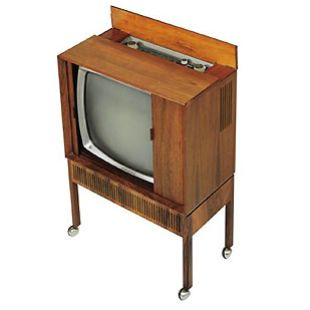Capri 611 FM Television

Manufactured: 1961 - 1965
Designer:
Colours:
Once the post-War TV boom was over, many of the manufacturers which had emerged during the 1950s disappeared, frequently because the market had become saturated. Others, including B&O, survived because of their foresight. They had begun to focus on other product areas.
Beovision Capri TV was as a result of this foresightedness. It came in various guises, including the Capri KJ (1962 - 1965), Capri SJ/FM (1961 - 1965), Capri Moderne (1963 to 1965) and Capri KL (1964 - 1965), Capri TV 611 FM (introduced 1964)
Capri TV 514K, 17"
Produced: 1958 - 1959
Price in 1959: 1895 DKK
B&O engineers, for instance, had seen that transistors would replace radio tubes – and realised that a new and exciting future lay before them. Radio with FM, stereophonic music and, perhaps later, even colour TV.
The television of the 1950s had every chance of becoming popular - and it did. Capri was an elegant little television that was available with a trolley, with fixed legs or as a shelf model. The cabinet was made of teak or high-gloss walnut, as used in furniture production. Because of innovations in the furniture industry in the use of materials, more and more furniture was being made of teak, but the products of the radio sector were walnut. Bang & Olufsen needed to adapt the products to the furniture that people had bought for their homes. Teak became popular. Over the next 6-7 years, Bang & Olufsen changed the selection of materials for its products from walnut to teak. Later, the more exclusive Brazilian rosewood came in the 1960s as an alternative to teak -cabinets. Capri was available in two different sizes, 17 or 21 inches.
One of the first major lessons learned about television was that reflected light could spoil the picture. People would often switch off the light in the room to give the picture some contrast while watching television. To protect their eyesight, people were advised to leave one lamp on in the room. To counter this problem, a solution was developed in the form of the 'Bang & Olufsen Spectral Filter' in anti-reflection curtains. It was a slightly tilted greyish screen in front of the picture tube. "Your eyes are protected and you can enjoy the programmes in a living room with full illumination," the 1959 sales brochure stated. The spectral screen was a simplified version of what is today called the contrast screen.
(Source: Beolink Magazine: 'The First 50 Years of Television' © Bang & Olufsen a/s 2002)
Capri 611 FM Television Product Specifications
Aerial impedance VHF: 750 ohms, could be altered to 240 ohms by removing transformer 972 H 85/507 L 745
UHF: 240 ohms only
Dimensions W x H x D, CAPRI FM KL 62,2 x 50,3 x 40,6cm
Dimensions W x H x D, CAPRI FM SJ 63,2 x 91,0 x 41,8cm
External speaker connection 3-5 ohms
Power consumption ad measured with moving-iron instrument: TV: 1100 mA (approx. 245 W)
FM: 300 mA (approx. 70 W)
GR: 250 mA (approx 55 W)
Power supply 220 V, DC or AC
Power output 2,5 W
Tuning FM tuner, 87,2 - 100,5 Mc/s. Had automatic frequency control (AFC)
VHF tuner with mechanical memory device, channels 2-11
UHF tuner with continuous tuning, channels 21-70,
470 - 870 Mc/s
Tape recorder connection Prepared for diode output
Valves PPC 189, VHF RF amplifier
PCF 86, VHF mixer
3 x EF 184, Video IF amplifiers
PCL 84, AGC and video output stage
A59 - 11W, Picture tube, 23 in. 114º
UCF 80 1, Noise inverter and 1st sound IF amplifier
UCF 80 2, AGC diode and 2nd sound IF amplifier
UCL 82, AF amplifier and output stage
PCF 80 3, Separator
PCL 85, Video output stage
ECC 81, Automatic line control
PCF 80 4, Line oscillator
PL 500, Line output
PY 88, Booster diode
DY 87, High voltage diode
UCC 85, FM RF amplifier and mixer
UCH 81, 2nd FM mixer
UM 84, Tuning indicator
Weight, CAPRI FM KL 30 kg
Weight, CAPRI FM SJ 35,5 kg
Related Products
- BeoVision Capri Range - Overview
- Capri Television
- Capri KJ Television
- Capri Moderne Television
- Capri SJ Television
Created: 20th January 2007
Modified: 20th February 2007
Author Notes:




